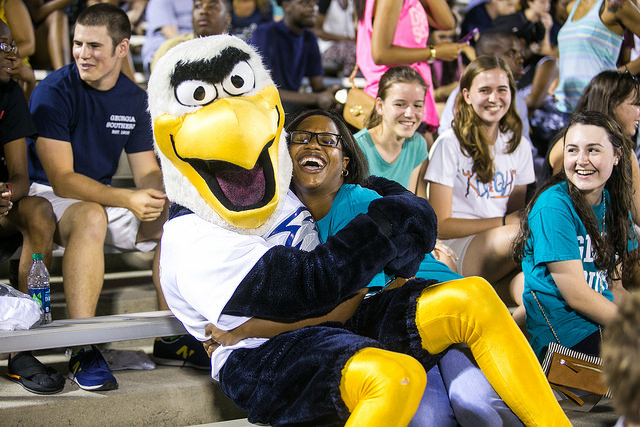30.2: Habits for Success
- Page ID
- 175769
\( \newcommand{\vecs}[1]{\overset { \scriptstyle \rightharpoonup} {\mathbf{#1}} } \)
\( \newcommand{\vecd}[1]{\overset{-\!-\!\rightharpoonup}{\vphantom{a}\smash {#1}}} \)
\( \newcommand{\dsum}{\displaystyle\sum\limits} \)
\( \newcommand{\dint}{\displaystyle\int\limits} \)
\( \newcommand{\dlim}{\displaystyle\lim\limits} \)
\( \newcommand{\id}{\mathrm{id}}\) \( \newcommand{\Span}{\mathrm{span}}\)
( \newcommand{\kernel}{\mathrm{null}\,}\) \( \newcommand{\range}{\mathrm{range}\,}\)
\( \newcommand{\RealPart}{\mathrm{Re}}\) \( \newcommand{\ImaginaryPart}{\mathrm{Im}}\)
\( \newcommand{\Argument}{\mathrm{Arg}}\) \( \newcommand{\norm}[1]{\| #1 \|}\)
\( \newcommand{\inner}[2]{\langle #1, #2 \rangle}\)
\( \newcommand{\Span}{\mathrm{span}}\)
\( \newcommand{\id}{\mathrm{id}}\)
\( \newcommand{\Span}{\mathrm{span}}\)
\( \newcommand{\kernel}{\mathrm{null}\,}\)
\( \newcommand{\range}{\mathrm{range}\,}\)
\( \newcommand{\RealPart}{\mathrm{Re}}\)
\( \newcommand{\ImaginaryPart}{\mathrm{Im}}\)
\( \newcommand{\Argument}{\mathrm{Arg}}\)
\( \newcommand{\norm}[1]{\| #1 \|}\)
\( \newcommand{\inner}[2]{\langle #1, #2 \rangle}\)
\( \newcommand{\Span}{\mathrm{span}}\) \( \newcommand{\AA}{\unicode[.8,0]{x212B}}\)
\( \newcommand{\vectorA}[1]{\vec{#1}} % arrow\)
\( \newcommand{\vectorAt}[1]{\vec{\text{#1}}} % arrow\)
\( \newcommand{\vectorB}[1]{\overset { \scriptstyle \rightharpoonup} {\mathbf{#1}} } \)
\( \newcommand{\vectorC}[1]{\textbf{#1}} \)
\( \newcommand{\vectorD}[1]{\overrightarrow{#1}} \)
\( \newcommand{\vectorDt}[1]{\overrightarrow{\text{#1}}} \)
\( \newcommand{\vectE}[1]{\overset{-\!-\!\rightharpoonup}{\vphantom{a}\smash{\mathbf {#1}}}} \)
\( \newcommand{\vecs}[1]{\overset { \scriptstyle \rightharpoonup} {\mathbf{#1}} } \)
\( \newcommand{\vecd}[1]{\overset{-\!-\!\rightharpoonup}{\vphantom{a}\smash {#1}}} \)
\(\newcommand{\avec}{\mathbf a}\) \(\newcommand{\bvec}{\mathbf b}\) \(\newcommand{\cvec}{\mathbf c}\) \(\newcommand{\dvec}{\mathbf d}\) \(\newcommand{\dtil}{\widetilde{\mathbf d}}\) \(\newcommand{\evec}{\mathbf e}\) \(\newcommand{\fvec}{\mathbf f}\) \(\newcommand{\nvec}{\mathbf n}\) \(\newcommand{\pvec}{\mathbf p}\) \(\newcommand{\qvec}{\mathbf q}\) \(\newcommand{\svec}{\mathbf s}\) \(\newcommand{\tvec}{\mathbf t}\) \(\newcommand{\uvec}{\mathbf u}\) \(\newcommand{\vvec}{\mathbf v}\) \(\newcommand{\wvec}{\mathbf w}\) \(\newcommand{\xvec}{\mathbf x}\) \(\newcommand{\yvec}{\mathbf y}\) \(\newcommand{\zvec}{\mathbf z}\) \(\newcommand{\rvec}{\mathbf r}\) \(\newcommand{\mvec}{\mathbf m}\) \(\newcommand{\zerovec}{\mathbf 0}\) \(\newcommand{\onevec}{\mathbf 1}\) \(\newcommand{\real}{\mathbb R}\) \(\newcommand{\twovec}[2]{\left[\begin{array}{r}#1 \\ #2 \end{array}\right]}\) \(\newcommand{\ctwovec}[2]{\left[\begin{array}{c}#1 \\ #2 \end{array}\right]}\) \(\newcommand{\threevec}[3]{\left[\begin{array}{r}#1 \\ #2 \\ #3 \end{array}\right]}\) \(\newcommand{\cthreevec}[3]{\left[\begin{array}{c}#1 \\ #2 \\ #3 \end{array}\right]}\) \(\newcommand{\fourvec}[4]{\left[\begin{array}{r}#1 \\ #2 \\ #3 \\ #4 \end{array}\right]}\) \(\newcommand{\cfourvec}[4]{\left[\begin{array}{c}#1 \\ #2 \\ #3 \\ #4 \end{array}\right]}\) \(\newcommand{\fivevec}[5]{\left[\begin{array}{r}#1 \\ #2 \\ #3 \\ #4 \\ #5 \\ \end{array}\right]}\) \(\newcommand{\cfivevec}[5]{\left[\begin{array}{c}#1 \\ #2 \\ #3 \\ #4 \\ #5 \\ \end{array}\right]}\) \(\newcommand{\mattwo}[4]{\left[\begin{array}{rr}#1 \amp #2 \\ #3 \amp #4 \\ \end{array}\right]}\) \(\newcommand{\laspan}[1]{\text{Span}\{#1\}}\) \(\newcommand{\bcal}{\cal B}\) \(\newcommand{\ccal}{\cal C}\) \(\newcommand{\scal}{\cal S}\) \(\newcommand{\wcal}{\cal W}\) \(\newcommand{\ecal}{\cal E}\) \(\newcommand{\coords}[2]{\left\{#1\right\}_{#2}}\) \(\newcommand{\gray}[1]{\color{gray}{#1}}\) \(\newcommand{\lgray}[1]{\color{lightgray}{#1}}\) \(\newcommand{\rank}{\operatorname{rank}}\) \(\newcommand{\row}{\text{Row}}\) \(\newcommand{\col}{\text{Col}}\) \(\renewcommand{\row}{\text{Row}}\) \(\newcommand{\nul}{\text{Nul}}\) \(\newcommand{\var}{\text{Var}}\) \(\newcommand{\corr}{\text{corr}}\) \(\newcommand{\len}[1]{\left|#1\right|}\) \(\newcommand{\bbar}{\overline{\bvec}}\) \(\newcommand{\bhat}{\widehat{\bvec}}\) \(\newcommand{\bperp}{\bvec^\perp}\) \(\newcommand{\xhat}{\widehat{\xvec}}\) \(\newcommand{\vhat}{\widehat{\vvec}}\) \(\newcommand{\uhat}{\widehat{\uvec}}\) \(\newcommand{\what}{\widehat{\wvec}}\) \(\newcommand{\Sighat}{\widehat{\Sigma}}\) \(\newcommand{\lt}{<}\) \(\newcommand{\gt}{>}\) \(\newcommand{\amp}{&}\) \(\definecolor{fillinmathshade}{gray}{0.9}\)Introduction
Learning Objectives
- develop a personal definition of success
- identify specific strategies to achieve success
- identify support network options
A college education is aligned with greater success in many areas of life. While enrolled in college, most students are closely focused on making it through the next class or passing the next test. It can be easy to lose sight of the overall role that education plays in life. But sometimes it helps to recall what a truly great step forward you are taking!

It’s also important to recognize, though, that some students do not succeed; they drop out within the first year. Sometimes this is due to financial problems or a personal or family crisis. But too frequently, students drop out because they’re having trouble passing their courses.
In this section, we examine the elements of college success. Are there patterns of success you strive for but aren’t yet reaching? Where might you shore up your support? What strategies can you use to achieve success in your college endeavors?
A Personal Definition for Success
 How do you define college success? The definition really depends on you. You might think that “success” is earning an associate’s degree or attending classes in a four-year college. Maybe success is a bachelor’s or master’s degree or a PhD. Maybe success means receiving a certificate of completion or finishing skill-based training.
How do you define college success? The definition really depends on you. You might think that “success” is earning an associate’s degree or attending classes in a four-year college. Maybe success is a bachelor’s or master’s degree or a PhD. Maybe success means receiving a certificate of completion or finishing skill-based training.
You might be thinking of other measures of college success, too—like grades. For instance, you might be unhappy with anything less than an A in a course, although maybe this depends on the difficulty of the subject. As long as you pass with a C, you might be perfectly content. But no matter how you define success personally, you probably wouldn’t think it means earning a D or lower grade in a class.
To help you start to define what success means to you, take this quick self-assessment about your college goals and beyond. How many of these items are important to you?
| I Want to Be Able to . . . | YES | NO |
|---|---|---|
| Change my major during my college years | ||
| Have good relationships with my professors | ||
| Be eligible for financial aid | ||
| Be eligible for scholarships | ||
| Get awards | ||
| Get reductions on my car insurance | ||
| Prove to my employer that I can work hard | ||
| Keep my parents happy | ||
| Make connections to get a job after graduation |
Finally, consider that we can’t be successful all the time at everything. We have to balance our energy and our focus, to get what we really want. The following video stresses the external factors that shape what we consider “success” as a society, and encourages us to think beyond these factors to determine what it really is that motivates us, personally–what we hope will define us, and our value, to others.
Strategies to Achieve Success
If most students believe that passing a class is the minimum requirement for “success,” and if most students want to be successful in their courses, why aren’t more college students consistently successful in the classroom?
Perhaps some common misconceptions are at play. For example, we often hear students say, “I just can’t do it!” or “I’m not good at math,” or “I guess college isn’t for me…,” or “I’m not smart enough.” But these explanations for success or failure aren’t necessarily accurate. Considerable research into college success reveals that intellect usually has nothing to do with having difficulty in or failing college courses. More often, success depends on how fully you embrace and master the following seven strategies:
- Learn how to take effective notes in class.
- Review the text and your reading notes prior to class.
- Participate in class discussion and maybe even join a study group.
- Go to office hours and ask your instructor questions.
- Give yourself enough time to research, write, and edit your essays in manageable stages.
- Take advantage of online or on-campus academic support resources.
- Spend sufficient time studying.
So if you feel you are not smart enough for college, ask yourself if you can implement some of these skills. Can you make more time for learning? One approach is to create a regular study schedule and make sure you allow yourself ample time. Most college success experts agree that students should study two hours outside of class for every hour in class. Only break away from your committed schedule if an extreme situation prevents you from sticking to it.
Another strategy to consider implementing is group study. For example, rather than relying just on your own knowledge, notes, and skills, try studying with other students in your difficult classes. Studying in a group gives every group member a chance to ask questions and talk about concepts.
 You can also add a tutor to your study group. You will really be able to notice a positive difference. Tutoring is generally free in college, and the strategies and knowledge you gain will be invaluable. Usually tutors have taken the class you are currently enrolled in, and they are trained to get the best out of you.
You can also add a tutor to your study group. You will really be able to notice a positive difference. Tutoring is generally free in college, and the strategies and knowledge you gain will be invaluable. Usually tutors have taken the class you are currently enrolled in, and they are trained to get the best out of you.
Overall, students struggle in college not because of natural intellect or smarts, but because of poor time management, disorganization, and lack of quality study time. The good news is that there are ways to combat this, specifically by doing things like creating a regular study schedule, studying in groups, and taking advantage of your school’s academic resources, like a tutoring center, instructor office hours, and any available online help.
Campus Support Networks
Whether your campus is small, tall, grande, or venti, you are probably amazed by the array of institutionally supported student activities available for your enrichment and enjoyment. Perhaps your biggest challenge is deciding how much extra time you have after studying and which added activities yield the greatest reward.
Benefits of Participating in Student Life
How is it that becoming fully involved in student life can have such a positive impact on student satisfaction and academic success?
The National Survey of Student Engagement—a survey measuring student involvement in academic and cocurricular activities—shows that student success is directly linked to student involvement in the institution. In fact, survey results show that the higher the level of student involvement is, the higher student grades are and the more likely students are to reenroll the next term. All of this seems to translate to satisfaction. The following lists some of the many benefits and rewards that result from active participation in campus and student life.
- Personal interests are tapped: Cocurricular programs and activities encourage students to explore personal interests and passions. As students pursue these interests, they learn more about their strengths and possible career paths. These discoveries can be lasting and life-changing.
- A portfolio of experience develops: Experience with just about any aspect of college life maybe relevant to a prospective employer. Is freshman year too soon to be thinking about résumés? Definitely not! If you gain leadership experience in a club, for example, be sure to document what you did so you can refer back to it (you might want to keep track of your activities and experiences in a journal, for instance).
- Fun leads to good feelings: Students typically pursue cocurricular activities because the activities are enjoyable and personally rewarding. Having fun is also a good way to balance the stress of meeting academic deadlines and studying intensely.
- Social connections grow: When students are involved in cocurricular activities, they usually interact with others, which means meeting new people, developing social skills, and being a part of a community. It’s always good to have friends who share your interests and to develop these relationships over time.
- Awareness of diversity expands: The multicultural nature of American society is increasingly reflected and celebrated on college campuses today. You will see this not only in the classroom but also in the cocurricular activities, clubs, organizations, and events. For example, your college might have a Black Student Union, an Asian Pacific Student Union, a Japanese Student Association, a Chinese Student Association, and many others. Having access to these resources gives students the opportunity to explore different cultures and prepare to live, work, and thrive in a vibrantly diverse world.
- Self-esteem grows: When students pursue their special interests through cocurricular activities, it can be a real boost to self-esteem. Academic achievement can certainly be a source of affirmation and satisfaction, but it’s nice to have additional activities that validate your special contributions in other ways.
All in all, being involved in the campus community is vital to every student, and it’s vital to the college, too. It’s a symbiotic relationship that serves everyone well.
The key to getting the most out of college is to take advantage of as many facets of student life as possible while still keeping up with your academic commitments. That’s pretty obvious, right? What may be less obvious is that focusing exclusively on your academic work and not getting involved in any of the rich and diverse cocurricular activities on campus can come at a real price and even hamper your success.
Major College Resources and How To Use Them
College resources to help you reach your educational and career goals are plentiful on most campuses. Here are several campus resources to know about and find early in your college career. You may not need them right away; some you may not need at all. But you will at least find several to be vital. Be familiar with your options. Know where to find the services. Have contact information. Be prepared to visit for help.
Advising
 Most colleges and universities assign an academic adviser to each student. The adviser may be associated with your major. There may also be an office or department that provides advising. Call upon your adviser or the advising office if you have an issue with your adviser or you need other help.
Most colleges and universities assign an academic adviser to each student. The adviser may be associated with your major. There may also be an office or department that provides advising. Call upon your adviser or the advising office if you have an issue with your adviser or you need other help.
Tutoring and Writing Centers
Tutoring and writing centers are established for all students, and seeking help from them is expected and to your advantage. Such services are covered by your tuition dollars, and they can richly enhance performance in any area of your studies. Know where to find these centers and how to schedule appointments.
Other Academic Support Facilities
Your college may also offer academic support in various other forms: for example, computer labs with trained assistants, tutors, mentors, peer advisers, and more. You can research what kinds of special support are available and be ready to take advantage of them.
Library Reference Desk
College libraries are staffed with professionals whose main function is to assist you and the college community in finding needed resources. Don’t hesitate to find the reference desk and get to know the reference librarians. Invariably you will learn about valuable resources—many of them online—that you didn’t know existed. Reference librarians are also educators, and they’re there to help you.
Campus Health Center
In the event that you need any health services whatsoever, the campus health center can be your first destination. Stop into the center and learn about the services offered, the hours of operation, emergency provisions, and routine health services available.
Campus Counseling
Counseling is an essential service that colleges and universities invariably provide. Services can ranges from life-saving care to assistance with minor concerns. Life stressors, such as deaths and divorces in the family, issues with friends, substance abuse, and suicide are just a few of the many issues that college students may experience or witness others struggling with. Don’t take matters into your own hands. Get help! The counseling center can help you and support you in gaining solid footing during difficult times. Don’t hesitate to take full advantage of the services and help they offer.
Career Services
One of the most important purposes of college is to prepare students for a career. All colleges and universities have a career office that can assist you with many critical aspects of finding a suitable career. It may also help you find a campus job or review options for your major, help you get an internship, draft your résumé, and practice interview skills. Visiting the career office is a must for every student, and it’s worth doing early and often (rather than waiting until you’re about to graduate).
Spiritual Life
Most college campus have interfaith facilities to meet the spiritual-life needs of the entire college community. You may find these facilities to be a refuge in special moments of need or resources for your ongoing involvement. A healthy spiritual life can bring greater balance to your student life.
Additional support centers that students may wish to visit include offices for financial aid, students with disabilities, housing, diversity, student organizations, athletics, continuing education, international students, child care, and many others. Refer to your college Web site or other college directory for information about the many, many services that can be part of your college experience.
- Revision, Adaptation, and Original Content. Provided by: Lumen Learning. License: CC BY: Attribution
- College Success. Authored by: Linda Bruce. Provided by: Lumen Learning. Located at: https://courses.lumenlearning.com/lumencollegesuccess. License: CC BY: Attribution
- Image of graduates. Authored by: Nottingham Trent University. Located at: https://flic.kr/p/a9W8ku. License: CC BY-NC-ND: Attribution-NonCommercial-NoDerivatives
- Image of woman smiling. Authored by: Felip1. Located at: https://flic.kr/p/riat9A. License: CC BY-NC: Attribution-NonCommercial
- Instructional Support: Options and Resources. Provided by: California Community Colleges Online Education Initiative. Located at: https://apps.3cmediasolutions.org/oei/11-Instructional-Support/story.html. License: CC BY: Attribution
- Image of four students. Authored by: UBC Library Communications. Located at: https://flic.kr/p/57H7r4. License: CC BY-NC-ND: Attribution-NonCommercial-NoDerivatives
- Image of mascot on woman's lap. Authored by: Georgia Southern. Located at: https://flic.kr/p/oELHWo. License: CC BY-NC-ND: Attribution-NonCommercial-NoDerivatives
- Image of library windows. Authored by: Matthias Ripp. Located at: https://flic.kr/p/qm8c8o. License: CC BY: Attribution
- Foundations of College Success: Words of Wisdom. Authored by: Thomas C. Priester, editor. Provided by: Open SUNY Textbooks. Located at: http://textbooks.opensuny.org/foundations-of-academic-success/. License: CC BY-NC-SA: Attribution-NonCommercial-ShareAlike
- Alain de Botton: A kinder, gentler philosophy of success. Authored by: TED. Located at: https://youtu.be/MtSE4rglxbY. License: All Rights Reserved. License Terms: Standard YouTube License



